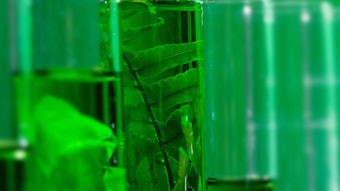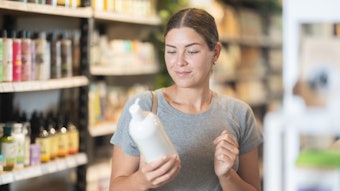Read previous beauty ingredient stories here.
The beauty industry is highly competitive, and brand owners are always looking to differentiate their products from the competition. Innovation in ingredients piques formulators’ and marketers’ interests alike, and is a must for any successful beauty brand. But beyond the marketing story and exotic formula must lie sound science.
Era of Natural
In the past, cosmetics were marketed primarily on emotions and the consumer’s psyche—how the product would make the consumer feel. However, as consumers’ expectations of benefits increased, brands have evolved. Scientific advancements have allowed companies to focus on form and function, pushing R&D and marketing in a new direction.
The driving force is, and will continue to be, the increasingly knowledgeable consumer. Manufacturers are competing for an ever-growing population of buyers who are becoming better informed and conscious about the ingredients that are going into and onto their bodies.
There will always be a place for vibrant colors and a playful attitude in beauty. But the new era of personal care focuses on the benefits of naturally derived ingredients and technologies. More than ever, consumers are motivated to pursue healthy, nourishing beauty that is linked to the world around them.
The beauty industry in turn has gone back to nature to develop the latest technologies and ingredients. Yet, keeping the environment in mind poses unique technical and sustainability challenges both inside and outside the lab.
Emulating Nature
Revolutionary innovations have resulted in technology that mimics nature, simultaneously making lives easier, healthier and more sustainable. A good example is the Australian red seaweed Delisea pulchra, which secretes furanones, natural chemicals that disable bacteria’s ability to colonize its surface.
Rather than killing the microbes, furanones interfere with their ability to communicate, thereby avoiding their capacity to build up a resistance. This clever antimicrobial mechanism provides just one example of the emerging field of biomimetics, which have the potential to generate new innovations created from biologically inspired engineering. It also makes for a good marketing story in today’s eco-friendly marketplace.
Algae Solutions
Household goods maker Kao Corp. is looking at algae for innovative, green solutions. The company has identified an enzyme that could lead to a non-food source of raw materials for surfactants and an alternative to palm oil and coconut oil. Their findings may dramatically accelerate the breeding development of algae for large-scale products of medium-chain fatty acids.
“Algae is a hot topic, now more than ever,” says Fanny Coste of Costemetics Consulting.
Not only is algae popular with consumers from a marketing standpoint as a natural ingredient, but sustainable sourcing objectives have prompted alternative growing techniques.
Coste notes, “Combining cultivation and digital tech is interesting. A lot of progress has been made in the past year, and the viability of algae is being demonstrated in the industry.”
One biotech developer and manufacturer of algae-based chemicals, and a supplier of related technologies for the food and beverage industries claims to have produced the world’s first commercial versions of high-purity beta-1,3-glucan from algae.
Found only in select species of algae, the cell wall of yeast and some mushrooms, beta-1,3-glucan has undergone decades of research showing its ability to support a healthy immune system. Algal Scientific has developed a proprietary recipe using the material that includes nutrients, minerals and vitamins.
From this recipe and a patent-pending process, Algal Scientific grows and harvests its own special algae, AlgaGlucan, the purified extract of beta-1,3-glucan produced by Euglena gracilis. It is grown in sterile fermentation tanks similar to the way that beer is produced—as well many biological products such as antibiotics. AlgaGlucan is in the final stages of regulatory approval for use in human nutraceuticals and subsequently in functional foods. Research has shown that topical use of this form of beta glucan provides skin benefits, yielding potential future applications in cosmetics and toiletries.
Specialty chemical supplier SEPPIC is also making advances on its ALGRAAL project, launched last year to develop new algal-based source fatty alcohols and emulsifiers for the cosmetic industry, as part of its efforts to focus on green, plant-based chemistry.
The project brings together private and public sector partners and is being supported by SEPPIC customers such as Clarins and Yves Rocher, who are ready to use this new raw material in their product formulations.
“SEPPIC is committed to innovation on a daily basis as part of its sustainable development policy, and has made it a priority in its R&D projects,” says Sandra Manceau, R&D, SEPPIC.
The company’s BiotechMarine subsidiary recently announced its breakthrough technology, Celebrity, which cultivates macroalgal cells in the laboratory to derive active ingredients for cosmetics. Inspired by the rich biodiversity of the sea surrounding France’s Bréhat archipelago, the cell culture technology makes it possible to create a bank of macroalgal cells from many untapped species with benefits for the skin that have yet to be explored.
“Macroalgae cells have the amazing ability to transform light and minerals into organic molecules,” explains Erwan Le Gélébart, R&D project manager. “This is a major innovation for the world of cosmetic active ingredients.” Using in vitro macroalgal cell cultures, the company is able to offer a new marine source of active ingredients for beauty applications.
The first of its kind is Ephemer, a gametophyte extract taken from macroalgae cells grown in a laboratory and harvested at an ephemeral stage in the lifecycle of the brown seaweed Undaria pinnatifida, or wakame. During this growth stage, the macroalgal cells accumulate antioxidant molecules. The in-vitro cultivation of macroalgae cells allows the supplier to stabilize the gametophytesm, which are found in very low quantities, and to multiply them in order to use their properties for cosmetic purposes.
Ephemer is purported to protect the skin, help reduce free radicals and preserve mitochondrial DNA for both long- and short-term benefits.
Green Partnerships
Last year, various other algal ingredients were launched by industry suppliers, including Symrise SymBronze1659, a self-tanner derived from microalgae Isochrysis galbana; Silab Deglysome, a firming ingredient rich in galactans from Hypnea musciformis algae; and Lipotec Actigym, a marine ingredient that—by mimicking the effect of endurance training—is directed at improving body definition and redefining areas sensitive to sagging due to aging or insufficient physical activity. This marine ingredient is an extracellular substance produced by a microorganism inhabiting Bermuda (Bacillus sp) and is part of Lipotec’s product brand Biointec. Tested in vivo, the company claims it induces adiponectin release from adipose tissue, enhancing metabolism.
Another active with innovative mechanisms of action from Lipotec is Nocturshape. The anti-cellulite ingredient takes advantage of human circadian rhythms by reducing levels of nocturnin, a protein that is involved in adipogenesis and lipid accumulation, specifically during the night.
In developing Nocturshape, Lipotec was inspired by chronobiological parameters being used in pharmacological studies for assessing the right time for the administration of drugs and the observation of their effects. “Similarly, it is essential to take into account the importance of circadian rhythms when developing and testing cosmetics,” says Cristina Davi, product manager.
Understanding the best time for the application of a product, as well as the biological rhythms of tissue and molecular mechanisms to be addressed, allows the active ingredient to potentially achieve more efficient results.
Lipotec invests significant resources in R&D in order to provide more innovative active ingredients with better efficacy to target each cosmetic need.
“The close relationship of Lipotec to academia, via numerous partnerships, and its pharmaceutical approach energize its impetus to research and ensure the extreme rigor of our cosmetic approach,” says Davi.
Mibelle Biochemistry is no stranger to novel sources of raw materials and innovative study methods. The Swiss company’s Snow Algae Powder claims a calorie restriction-mimetic anti-aging effect. Calorie restriction is a nutritional longevity theory and mechanism for increasing the lifespan of organisms. Mibelle has adopted this concept and applied it to cosmetic formulations to activate these biochemical pathways in skin cells. Following years of research, scientists found that the valuable stress response molecules produced by algae with the ability to survive in the extreme environmental conditions of glaciers can also effectively help protect the youthfulness of the skin.
Based on the extract of this unique algae, Snow Algae Powder stimulates the longevity gene Klotho and activates AMPK (AMP-activated kinase), an energy sensor that stimulates energy production from glucose and fatty acids and inhibits energy consumption. Mibelle claims that, together, they mimic the effects of caloric restriction and optimize skin metabolism, leading to improved cellular defenses, oxidative stress resistance, cell detoxification and repair. Clinical studies have shown that the patented Snow Algae Powder improves the dermal/epidermal papillary skin structure. Mibelle cultivates snow algae cells in an in-house photo bio reactor in conditions mimicking their natural environment.
Brands can partner with such suppliers that have science and nature in mind for ingredient innovation, as well as green business practices.
Renewable oil and bio-products company Solazyme, Inc., which makes algae-based ingredients for skin care, as well as industrial uses, food and fuel, recently announced the introduction of sustainable algal oils for one of Unilever’s biggest soap brands, Lux. Solazyme’s algal oils are derived from oil-producing microalgae that are cultivated sustainably and responsibly. The oils are produced in a matter of days using a fermentation process designed to yield oils in the highest purity and performance. Unilever’s use of the oils is part of the brand’s effort to double the size of its business while reducing its overall environmental footprint.
“Through incorporating algal oils into our Lux products, we have a unique opportunity to make a difference on a large scale, as we help develop a raw material that we know has been responsibly sourced,” says Anne Radmacher, Lux Global Brand vice president.
Unilever and Solazyme have been collaborating for five years on multiple projects, culminating in a supply agreement covering the first of Solazyme and Unilever’s jointly developed oils. The vast majority of the tailored oil for the soap products will be produced in a new renewable oils facility in Moema, Brazil.
With the current consumer environment requiring a new level of discipline in how the industry thinks and communicates, building a narrative for your brand requires planning and cooperation between marketing and R&D, whether through partnerships or in-house.
Scientific Integrity
While infusing science in the name of marketing seems to be the trend, doing so without the integrity of sound science may result in being dismissed, or worse.
“The cosmetics industry often has been castigated for ‘inventive’ marketing, but the industry also features some very inventive science,” says Joe Schwarcz, PhD, Director of McGill University’s Office for Science & Society.
Schwarcz is an author advocating against junk science and will speak of the need to demystify cosmetic science during the Cosmetics & Toiletries Summit in June 2015.
While the potential of future science is never-ending, there is a limit to what products can do within the definition of “cosmetics.” The challenge then for cosmetic manufacturers is to develop products that can be scientifically shown to improve the appearance of the skin without causing significant changes in its structure.
“In recent years, cosmetic chemists have managed to infuse products with a great deal of science, but miracles remain elusive,” says Schwarcz, who asserts cosmetics is a blend of science and hope. “Science is a process used to search for the truth. It is not a collection of unalterable truths; it is, however, a self-correcting discipline.”
One step forward, two steps back. However, as more scientific knowledge accumulates, the chances of making substantial progress increases. Those with the foresight to be active participants in the developmental process suited for today’s evolving market can position their product for success.
By taking advantage of cutting-edge science and utilizing unique advantages of an innovation, brands can provide the greatest value of a product to those intended to benefit the consumer, and inspire action at the retail shelf.










